Mixing
Vessels |
 |
 |
 |
 |
Krater |
Ancient Greeks had usually drunk wine mixed with water.
"Krater" is a mixing bowl and the name is
from the word "Kerannmi" means to mix.
Krater usually has a round body, a wide mouth, a heavy
stand and a handle on either side, and is generally
classified into four types from the shape of the body
or the handles. "Volute
Krater" has a handle on either side which is
in the form of a spiral . "Column Krater" has a handle formed columnar shape.
"Calyx Krater"
has a body in the form of the calyx. "Bell
Krater" has a body formed of an inverted bell.
In the early year of the black-figure, "Skyphos
Krater", which has a round bowl, a domed lid
with a knob and a high stand, was made. |
 |
Volute Krater |
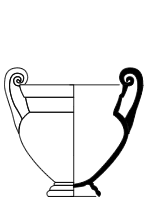
Round body, a offset neck, a heavy stand and two
handles which is in the form of a spiral with flanged
sides rising from loops on the shoulder to above to
the rim. This shape was introduced in the second quarter
of the sixth century, though the examples with the
black-figure are rare and flourished after the end
of the century. Cf. Paris, Louvre CA3482 (Perseus
Project). Workshops of Apulia, a Greek colony
in South Italy, favoured this shape.
The form became slenderer as time went by and Gorgoneia,
masks of the Medusa, are applied on the volutes of
the handles in Apulia. Figured scene is arranged on
either side of the body and sometimes on the neck.
Usually flower ornaments flourish the vase.
Dimensions: height about 70cm, though there are many
vases over 1m high in apulian vases.
|
 |
Column Krater |
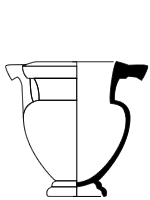
Round body, a offset neck with a thick lip and a heavy
stand. Each handle consists of a pair of cylindrical
stems terminating in a horizontal member joined to the
rim.
This shape was produced from the first half of the sixth
century and favoured till the third quarter of the fifth,
then losed its popularity.
Figured scene is usually arranged in the paneled picture
on the body. The lip sometimes has a animal frieze drawn
by the black-figure. The ornament is simple and often
a bud pattern is arranged on the neck. Cf. Harvard 1925.30.125 (Perseus
Project).
Dimensions: height about 40-50cm
|
 |
Calyx Krater |
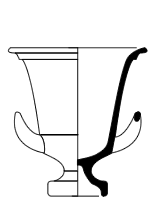
Deep body with the lower convex, the upper slightly
concave. A heavy stand and handles which are set at
the top of the lower part, curve upward.
The first example was maybe produced by Exekias in about
530B.C. In the age of the red-figure, this shape was
favoured and used till the end of this technique.
A frieze picture is arranged on the upper part without
a interruption by the handles. A palmette pattern is
usually arranged on the lower part. Cf. Harvard1959.236 (Perseus
Project).
Dimensions: height about 40-50cm, and over 60cm in the
late red-figure |
 |
Bell Krater |

Bell shaped body with loop handles placed high on the
body and curving slightly upward and a heavy stand.
Some early example have not loop handles but lugs.
This shape was introduced after the beginning of the
red-figure and especially favoured after the middle
of the fifth century.
The figured scene is arranged on the body and the ornament
is very simple. Cf. Harvard 1960.343 (Perseus
Project).
Dimensions: height about 40-50cm |
 |
Skyphoid Krater |
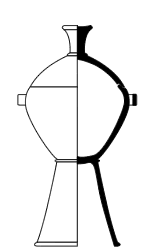
Round bowl with small handles, conical lid with a tall
knob and tall stand. This shape was preferred only in
the early black-figure.
Figured scene is arranged on the lid, the body and the
stand and animal friezes are favoured.
Dimensions: height about 100cm
|
 |
Dinos |
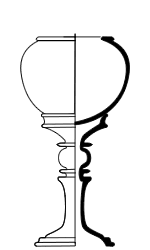
Deep bowl with round bottom sometimes with a stand,
which is needed for the shape. The name "Lebes"
must be used for this shape, though "Dinos"
was used for the cup and not correct name. Cf. Paris, Louvre E874 (Perseus
Project).
This shape was most favoured in the early black-figure
and painted by the red-figured painter, though not so
many example is left.
In the black-figure, the pictures are arranged as friezes,
sometimes with animals. Some example has a figured scene
on the rim. Red-figure painter preferred to arrange
the wide picture on the body.
Dimensions: height about 20cm, and about 70cm with its
stand. |
|
 |
|
|
|